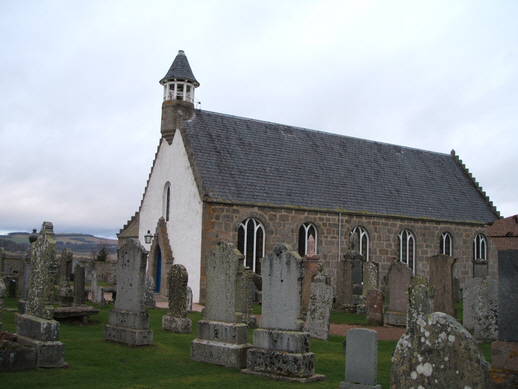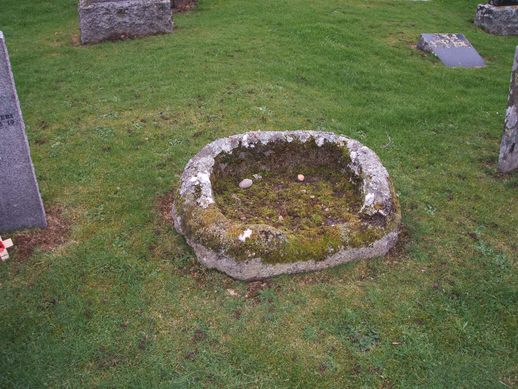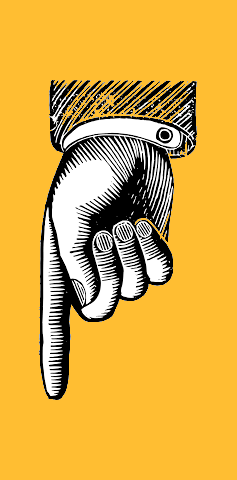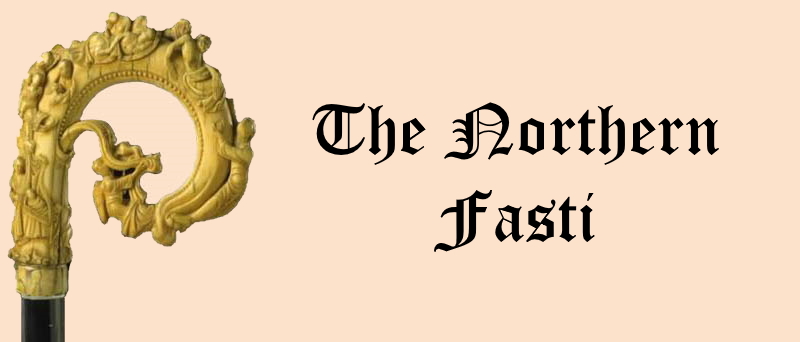Strathspey Deanery
Abernethy
(Aberneich)
Parish Church: OS Ref: NGR NJ 006218 H.E.S. No: NJ02SW 29 Dedication: St George
Associated Chapels: Congash {NGR: NJ 058262}; Lethnachyle {NGR: NJ 062187}.
As its name indicates, the barony of Abernethy is situated in the district surrounting the River Nethy, especially at or near its confluence with the River Spey, of which it is a tributary.
Tradition relates that certain parts of the Barony of Abernethy (the dabhaichean of Gartenmore, Rymore and Tullich) formed a part of the estates of the powerful Comyn family, Lords of Badenoch, who flourished in the thirteenth and the early part of the fourteenth century.1 The remains of their caput, Castle Roy or the Red Castle
A church was planted just beside Castle Roy at a very early date, perhaps as far back as 1226. However, there is a suggestion that the first real centre of population was established further up Strath Nethy, and that this, therefore, was where the very first church was built, during the time of the Early Church, at Lethnachyle.
The present parish church bears a dedication to St George, but it is possible that this was of a later date and that in its earliest days, it bore the name of one of the Saints of the Early Church.4 Fawcett considers that this was a 'common church' of the Church of Moray. Certainly, parts of the lands of Abernethy were the property of the bishop, although it was only in 1226 that a dispute over church lands was finally settled. Both the parsonage and the vicarage tithes were appropriated to the Common Fund of the cathedral and the parish was, from that time, served by a succession of 'stipendiary curates.' The local priest had the use of a half-dabhach of land near the church, on which his dwelling was situated, and the bishop also retained a half-dabhach of the parish lands for himself, becoming part of the episcopal demesne or 'mensa'.5
The church of Abernethy would seem to have always maintained a position as the 'senior' church in this part of Strathspey. This has continued into recent times with the establishment here of the seat of Presbytery.
As we have seen, from early times, the priest had a 'half dabhach' of land for his use and he would have used it in the same way as any other 'farmer' - to grow crops and graze his cows and horses. It is very likely that he would have employed men to help him in this. However, in 1866, the heritors and Presbytery allowed him to let the glebe in order to augment his income. The glebe was eventually sold in 1929 and it then comprised 23½ acres even after part had been sold to the local golf course. This is not an inconsiderable portion of land. The eighteenth century manse at Aberethy is now the building which houses the Abernethy Outdoor Centre which is sustantial. Construction was begun on the instructions of the then Duchess of Gordon c.1736, she being then one of the heritors.

Tradition says that Abernethy church was the scene of a terrible tragedy in the fifteenth century. "The story is that, in the 15th century, the Laird of Grant or his son was murdered by the Cummings when on a visit to the Barons of Kincardine. The murderers were pursued, and took refuge in Abernethy church. The Grants, with their friendes the Stewarts, shrank from desecrating the holy place, but one of their number solved the difficulty by shooting a burning arrow into the heather-thatched roof. The building was soon in a blaze, and all the Cummings perished save one, a man of gigantic stature, who forced his way out, but was afterwards killed by the blow of a two-handed sword, 'which sword,' says the chronicler, 'to this day lies in the representative of Clan Cheran's house.'6

1187 x 1203 (15 March) Richard [of Lincoln], bishop of Moray, by the grace of God, greetings in the Lord to all the children of the holy mother church. Let all in the present and the future know that I have granted, and confirmed by this present charter, that, for the love of God, the church of Abernethy, with all its just appurtenances, should be held by Patrick son of William in free and pure alms, as freely and quietly as our other clerics in our diocese freely hold and possess their churches, save the episcopal dues ('episcopalibus'). We have also granted to him our land, that is to say, the half dabhach which faces the aforesaid church, to be held by him as long as he lives, paying to us 3 shillings annually at the feast of St. Martin. Witnesses: Master Robert, archdeacon [of Moray]; Brice, dean [of Elgin Cathedral]; Lambert, chaplain, parson of Kintrae; Hugh, clerk, parson of Dipple; Henry, brother of the bishop, parson of Spynie; Samuel, presbyter; Isaac, presbyter; and many others. Amen.7
1226 Following a dispute between Andrew, the Bishop of Moray, and James the son of Morgund, over certain lands in the feu of Abernethy [Abirnythy] in Strathspey, i.e. a certain portion of land at Coulnakyle (Cuneneges / Coningas), land which was said to belong to Abernethy; and over the teinds of cain which were customarily paid to the King from the said feu before the infeftment of the said James and his heirs, shall be quit for ever from every demand and dispute brought regarding the aforementioned. The end result was that: James and his heirs were to be freed from all exactions made by the Bishop and the Dean and Chapter, and in return bound himself to provide 'a suitable manse near the Church, with a croft extending to one acre convenient thereto, and also to pay one mark sterling yearly to the bishop (half at Pentecost and half at Martinmas) in token of the agreement being firmly and perpetually observed.' Witnesses: Thomas, prior of Urquhard; Henry, dean of Ross; Simon parson of Roscolpyn8; Robert, dean of christianty of Inverness; William, dean of christianty of Strathbogie; Gregory, dean of christianty of Strathspey; Ralph, the bishop's chaplain; Robert, vicar of Elgin; and many others. Enacted at the Diocessan Synod held in the church of St Giles the abbot, Elgin, on the 5th of May, 1226.9
1239 (30 December) On this day, Andrew de Moravia, bishop of Moray, gave to the common fund of the canons at Elgin Cathedral, the churches of Farnua, Birnie and Bona (Abriachan) all in their entirety; also the churches of Logykenny (Laggan), Kincardine in Strathspey, Abernethy, Altyre, Barevan, and Arndilly (from the gift of William de Moravia, but excepting the chapel of Boharm), all in their entirety but in each case saving the half dabhach of land belonging to the episcopal mensa.10 Also, saving the tenures of those who, at the time of this writing, possessed them by right in perpetuity during their lifetimes. Saving also to himself and his successors the right of canonical jurisdiction and episcopalibus. Witnesses: Herbert, abbot of Kinloss; William, prior of Urchard; Simon, prior of Pluscarden; brother Alan; Walter and Archibald and Andrew, bishop's chaplains; master Walter de Crawford; Henry de Douglas and Matthew, bishop's clerks; and others. Enacted on the last day of the month of December, 1239.
| Name | OS Grid Ref. | Extent | Including | Barony |
|---|---|---|---|---|
| Auchnaconalin: | 1 dabhach | |||
| Rivalk | ||||
| Culnafin | ||||
| NJ 062188 | Loinchyle (Lynhill) | |||
| Eskinluchlaid | ||||
| NJ 063182 | Tobberay | |||
| NJ 056186 | Lantichen | |||
| NJ 056191 | Laggandow | |||
| Clachaig: | NJ 023185 | 1 dabhach | Abernethy. | |
| Croftnacardach | ||||
| Poulnastank | ||||
| Luibnadow | ||||
| NJ 025170 | Lyngarve | |||
| LynMcGilbert | ||||
| Dagbihainaik | ||||
| Inchtomach | ||||
| Struhanlea | ||||
| Renachcar | ||||
| Ruderuiclywa | ||||
| Badiechaple | ||||
| Galdnahairn | ||||
| Bellifurth: | NJ 015236 | 1 dabhach | Abernethy. | |
| Polchristan | ||||
| Auchchernack | ||||
| Backucharn | ||||
| Culnakyle | ||||
| Belliemore (Oldtoun of Abernethy) |
NJ 004217 | 1 dabhach | Abernethy. | |
| NJ 012227 | 2 crofts at Culraich | |||
| Bellnaclach | ||||
| Baddiniden | ||||
| Rynachatinhan | ||||
| c.NJ 13_230 | Glenlochy | |||
| NJ 122203 | E & W Glen Brown | |||
| Belnaclaigh | ||||
| Croft McQueen | ||||
| Lynebeanteine | ||||
| Muckerach | NJ 064173 | 1 dabhach | Abernethy. | |
| c.NJ 062166 | Drum | |||
| c.NJ 082163 | Dell | |||
| NJ 068172 | Ballintuim | |||
| NJ 062175 | Ellan | |||
| Stranchamnerich | ||||
| NJ 097176 | Litteratin | |||
| Knockmachernie | ||||
| Lurg of Clackack | ||||
| Culnakyle & Riemore | NH 998215 | 1 dabhach | Abernethy. | |
| Balnagown | ||||
| Carrechullie | ||||
| Easter Conygnes (Aultcharn) |
1 dabhach | Abernethy. | ||
| Wester Conygnes | 1 dabhach | Abernethy. | ||
| NJ 056258 | Balnatau | |||
| NJ 050256 | Inchbrock | |||
| NJ 051250 | Topperfettle | |||
| NJ 055248 | Ballinluig | |||
| NJ 066241 | Lynmore | |||
| Glenlochy | ||||
| Rothemune | NH 996209 | 1 dabhach | Abernethy. | |
| Cullivullin | ||||
| Balnagown | ||||
| Gartenmore | NH 948190 | 1 dabhach | Badenoch. | |
| NJ 183417 | Tomdow | |||
| Croftindam | ||||
| NH 950183 | Mulingarroch | |||
| Tomellochin | ||||
| Sleich | ||||
| Easter Tulloch | NH 978158 | 1 dabhach | Badenoch. | |
| NJ 012147 | Rinatten | |||
| Achderdanach | ||||
| NH 993157 | Rinanwan | |||
| Croft Chorie | ||||
| West Tulloch | 1 dabhach | Badenoch. | ||
| Lettoch | NJ 024193 | 1 dabhach | Abernethy. | |
| NJ 024207 | Garlyne | |||
| Newtown | ||||
| Conage | ||||
| NJ 022211 | Croftmaqueen | |||
| Corrichulie | ||||
| Allen | ||||
| Laggan | c.NH 96_20_ | 1 dabhach | Strathspey. | |
| (Garlin) see Lettoch | 1 dabhach | |||
| Gorithmemon same as Rothemune? |
1 dabhach | |||
| Rathemoine | ¾ dabhach | |||
| Aldtoun | ¾ dabhach | |||
| Achernach | ½ dabhach | |||
| Badnyden | ||||
| Bachcharn | ||||
| Croft Bolebain | ||||
| Culnakyle | NH 998215 | ½ dabhach | ||
| Belliefurth | NJ 014236 | ½ dabhach | ||
| Lennacheil | ½ dabhach | |||
| Bellisnet | ½ dabhach | |||
| Riemore | ½ dabhach | Abernethy. | ||
| Croft Chlerich | ||||
| Rienanuan | ||||
| Lynnamber | ||||
| Auchdergranach | ||||
| Runerrech | ||||
| Kicknanlupe | ||||
| Rinanache (part of Gartinbeg) |
¼ dabhach | |||
| Glenbroun (part of Bellimore) |
¼ dabhach | |||
| Coullmullin (part of Rathemoine) |
¼ dabhach | |||
| Lenzig (part of Clachaig) |
¼ dabhach | |||
| Coninche (part of Lettoch) |
¼ dabhach | |||
| Lettoche | NJ 024193 | ¼ dabhach | ||
| Information from Ross (2003).11 Locations by David at Cushnie Enterprises. | ||||
1. Fraser (1883), i., pp. lxx-lxxiii. The dabhacha of Gartenmore, Rymore, and Tulloch, in Abernethy parish, along with the dabhacha of Tullochgorum, Clourie, and Cour, all in Inverallan parish, were part of the lordship of Badenoch. Return to Text.
2. R.E.M., no. 264, p. 342. The lands of the whole earldom are listed in some detail which reveals the significant 'estate' that it now comprised. Return to Text.
3. A more detailed account of this whole question may be obtained in Simon Forder's excellent page on the Castle Roy Website. Return to Text
4. Mackinlay (1914), p. 465. "The church of Abernethy on the Spey owed allegiance to St. George, at least during the later Middle Ages, though earlier it probably had some Celtic saint as its titulat." Return to Text.
5. Fawcett & Oram (2014), p. 124; R.E.M., no. 283, p. 367. Return to Text.
6. Forsyth (1900), pp. 93. Return to Text.
7. S.E.A., i., no. 112; R.E.M., no. 44, pp. 38-39. Return to Text.
8. See n. 12, in The Synod of St Giles, for the suggestion that this is Roskeen parish. Return to Text.
9. R.E.M., no. 70, pp. 76-77. Return to Text
10. R.E.M., no. 41, pp. 35-36. Return to Text
11. Ross (2003), ii., p.121. Return to Text
12. Canmore Database, Site Number NJ01NE 80. https://canmore.org.uk/site/365231/nethy-bridge-dorback-estate Return to Text
Fawcett, R. and Oram, R. (2014) Elgin Cathedral and the Diocese of Moray, Edinburgh, Historic Scotland. Return to Text.
Forsyth, W. (1900) In the Shadow of Cairngorm: Chronicles of the united parishes of Abernethy and Kincardine, Inverness: The Northern Counties Publishing Company, Ltd. https://ia601605.us.archive.org/25/items/inshadowcairngo00forsgoog/inshadowcairngo00forsgoog.pdf
Fraser, Wm. (1883) The Chiefs of Grant, Edinburgh. Published by the Grant family in 3 volumes.
Innes, C. (1837) Registrum Episcopatus Moraviensis: e pluribus codicibus consarcinatum virca A.D. MCCCC, cum continuatione diplomatum recentiorum usque ad A.D. MDCVVIII, Edinburgh: for the Bannatyne Club. [R.E.M.]
Mackinlay, J.M. (1914) Ancient Church Dedications in Scotland: Volume 2, Non-Scriptural Dedications, Edinburgh: David Douglas.
Shead, N.F., (2015) Scottish Episcopal Acta, Volume 1: The Twelfth Century, [Scottish History Society, 6th Series, Volume 10], Woodbridge, Suffolk: The Boydell Press. [S.E.A., i.]
Theses.
Ross, A.D. (2003) The Province of Moray, c.1000-1230, unpublished PhD thesis presented to Aberdeen University, 2 volumes.
e-mail: admin@cushnieent.com
© 2023 Cushnie Enterprises


